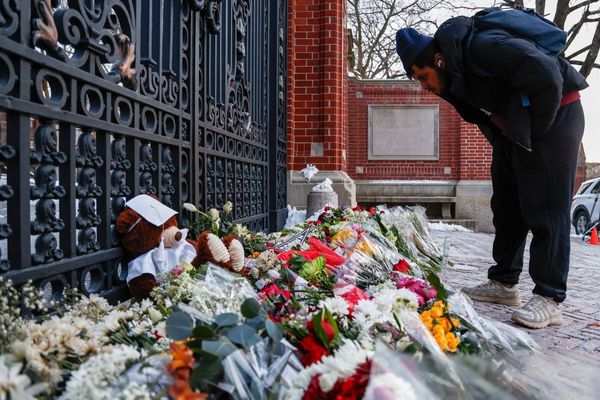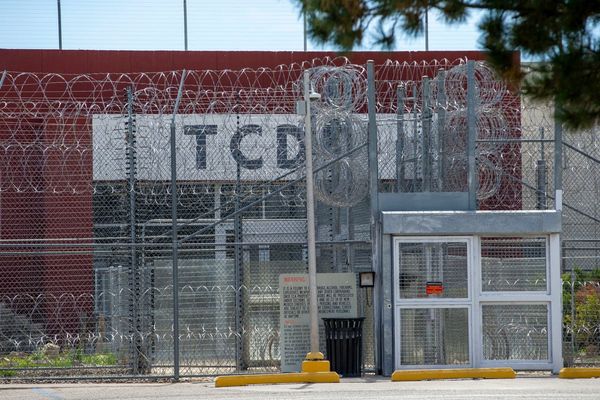
In a gully between the dirt road and a field of softly waving grass, a brolga stands, straightens its elegant grey neck and gazes at the two four-wheel-drives crawling to a halt a short distance away. In the centre of a lagoon on the other side of the road, a second brolga sits atop a tiny island, its orange head bowed.
Brolgas are common in northern Australia but are endangered in Victoria. One of the most reliable places to see them, though, is here: in the wide grassy plains, ponds and marshlands of Melbourne’s largest sewage farm, the Western Treatment Plant.
It may seem an unlikely bird haven, but the abundance of birdlife at the Western Treatment Plant famously rivals Kakadu. South of Werribee, at the edge of Port Phillip Bay, nearly 200 man-made lagoons and natural wetlands sit side-by-side across the 105 sq km site. More than 300 species of birds have been recorded here, including many threatened species. Due to the constant supply of wastewater, the area is protected from drought, and in dry years has become a refuge for half of Victoria’s waterfowl. It was formally listed under the Ramsar convention in 1983 as an internationally significant wetland.
It was the brolgas that first brought Michael Livingston – or “Bird Michael from the internet”, as he is affectionately known to many – out here a decade ago. He had been birding for a few years by then (“I saw a woodpecker in Sweden and got carried away”) but had never made the trip to the treatment plant.
“It was like a mythical place – Melbourne’s hottest birdwatching spot. And I didn’t drive or have a car, so it was always kind of out of range for me,” Livingston says.
“Then my friend [nature writer] Harry [Sadler] and I heard about the brolgas down here, and we schlepped our bikes on the train and rode down. I’d never seen brolgas before and had pictured them as being Northern Territory birds. I was shocked they were even in Victoria, and we saw them quite close up and they were just stunning.”
They weren’t able to see much of the place, having only their bicycles, but the day left a vivid impression.
“It was a beautiful, sunny, crisp morning and we were just overwhelmed by the number of birds of prey – coming down Point Wilson Road and seeing brown falcons and black kites in all the trees,” Livingston says. “From that day on I would just cajole my various friends to drive me down and tour me around.”
Birds of prey are out in force the day Guardian Australia heads out there with Livingston as our guide. A whistling kite loops overhead before we’ve even opened the gate. Livingston points out its paddle-shaped tail, distinguishing it in flight from the V-shaped tail of a black kite. Within minutes we’re able to compare them directly, as a black kite lands on a nearby fence. A short time later, a nankeen kestrel perches atop some foliage, and two swamp harriers emerge from the reeds beside a pond. As we head towards the bird hide on the edge of the bay, a white-bellied sea eagle crosses low above us, pursued by a raven.
It being an active industrial site, access to the Western Treatment Plant requires a gate key. Birdwatchers can apply online to borrow one for a day, or for those who are really keen, two years. (Livingston, naturally, has one.)
The site has been critical to Melbourne’s waste management since it opened as the Werribee Sewage Farm in 1892. The waste was used initially to irrigate crops, paddocks flooded with sewage that evaporated or sank into the earth. Livestock grazed on the paddocks to keep the grass low, becoming so well-fed and healthy they won agricultural prizes.
In the centre of the site stands the heritage-listed remnants of the township of Cocoroc, established to house the sewage farm’s workers. The last residents left in the 1970s, but some structures are still standing, including a swimming pool and a striking 682,000-litre water tank, erected elsewhere in 1854 as part of the first public water supply system in Victoria, and moved to Cocoroc in 1892.
Now, more than 200bn litres of sewage each year flow through the plant, pumped slowly through a series of huge lagoons designed to encourage and discourage growth of different kinds of bacteria. Anaerobic lagoons – ponds covered in huge lids to keep out oxygen – speed up decomposition of organic material and trap gases like methane (the gas is used generate the electricity that powers the plant), while the uncovered oxygenated aerobic ponds help reduce the level of nitrogen in the water. It takes about 35 days for wastewater to reach the final lagoon, where it can be recycled further or pumped into Port Phillip Bay.
The abundant birdlife is a direct result of this process, says Cody McCormack, conservation and land officer with Melbourne Water.
“The water that goes out into the bay at the end result of the sewage treatment process does still have a lot of nutrient in it,” he says. It’s class C recycled water at that point, suitable for livestock grazing and for use on some human food crops.
A certain amount of gunk in the water is necessary to maintain the biodiversity of the site, a fact that became apparent after a well-meaning clean-up effort about 20 years ago saw pure recycled water running into the bay – and birdlife at the plant declining sharply.
“We have to meet certain guidelines to protect the bay, so there’s not too much nutrient going out causing algal blooms. But that nutrient goes out on to the sand and feeds a lot of the organisms that exist in that area. And that provides food for the migratory shorebirds,” says McCormack.
McCormack is responsible for managing biodiversity and habitat on the site. Along with pest control and monitoring wildlife health, much of his job, especially in summer, involves carefully calibrating the water level of the 32 conservation lagoons in the complex to create the right balance of mud, water and vegetation.
“The nutrient in the water provides the food for the insects and for the vegetation to grow as well,” says McCormack. “It’s one of the most annoying things in my role, where I’m lowering these ponds to create these beautiful mudflats for shorebirds, but as soon as you expose the mud, there’s so much nutrient in the water that all the vegetation grows up, which the shorebirds don’t like. They want mud.” He laughs.
McCormack is a birder, too. “I think that’s what kind of got me this job, to be honest,” he says. “I love the migratory shorebirds that come in in spring. They are just the most incredible animals. This tiny little thing that fits in the palm of your hand and it’s travelled, like, 12,000km to get here.”
And of course, there are the orange-bellied parrots. Small, extremely rare and critically endangered, OBPs breed in Tasmania over summer and migrate to the Victorian coast in autumn, wintering in coastal saltmarsh areas. There are fewer than 100 left in the wild, and the Western Treatment Plant is one of a handful of places they can be seen in winter.
“We have seen 13 this year so far,” says McCormack. It’s the highest number for some years.
Livingston has also seen orange-bellied parrots here – just once – a sight that moved him and his companion to tears. “It was a really lovely moment, really special,” he says.
McCormack takes us to the place the parrots have been spotted recently. We peer at the saltbush through our binoculars, cross our fingers and wait, but none appear. It’s disappointing, but the most important attributes for a good birder, says Livingston, are patience and “resilience to failure”.
“The number of trips I’ve gone on trying to see some particular bird, where you go home having seen lots of other great birds but not the one you’re looking for – you have to be OK with that,” he says.
“But mostly it’s just putting yourself in the right place, being still and paying attention. And once you get into it, you find yourself always paying attention. One track of my brain is always listening for bird calls. I don’t even realise I’m doing it … I think it changes your relationship with the broader world.”
• This article was amended on 22 September 2025. In an earlier version, a picture caption described an orange-bellied parrot as nesting at the Western Treatment Plant; in fact, these birds over-winter in Victoria and nest in Tasmania.







